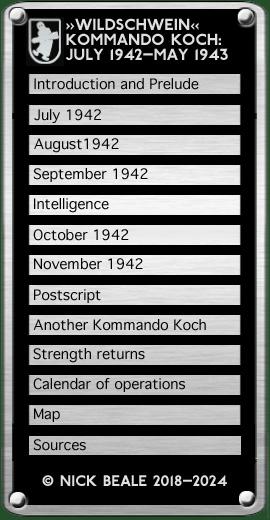|
Here the story seems to end for despite (at the time of writing) having followed ULTRA traffic and British intelligence summaries through to the end of December 1942, I have found no further mention of Luftwaffe airborne jamming operations in the Mediterranean Theatre. Sonderstaffel Koch still features on the Fliegerkorps X order of battle for the morning of 26 November, with a strength of 8 (5) aircraft but a week later it has gone. There are a number of possible explanations for this apparent cessation (permanent or temporary) of activity including:
As 1942 drew to a close, RAF’s Operational Research Section in the Middle East published an assessment of jamming in the Eastern and Central Mediterranean between late August and mid-November. This was based primarily on the experience of No. 221 Squadron’s ASV Wellingtons, acknowledging that Allied attacks on shipping: … relied to a very great degree on the ability of ASV shadowing Wellingtons to find the enemy. It was only when this had been done that the striking forces of bombing or torpedo-carrying aircraft could be brought up by means of the air-to-air W/T homing method, and in the later stages by flare dropping. This suggests that the Luftwaffe jammers had been attacking a crucial link in the system. On night operations between Crete and Tobruk in October–November 1942 the ASV Wellingtons did not carry torpedoes and the strike Wellingtons had no radar, the latter relying on the former to find the targets and bring them in by W/T homing. Once the torpedo force arrived, the search aircraft dropped flares first as guidance and then in a “curtain” to illuminate the hostile ships during the actual attack. Although “at first the jamming was a serious annoyance to ASV operators, the percentage of search aircraft which located their target did not sensibly decrease because of it”. RAF Middle East had not been able to investigate the German transmissions comprehensively, basing much of its analysis on reports brought back by aircrew. Although a standard reporting form had been drawn up, it had to be accepted that investigation must come second to finding and attacking Axis convoys. However: Broadly it seems that the enemy was relying in the main on a network of ground jamming stations situated on high ground at various points around the Mediterranean coast … In addition … it is known that he employed a number of airborne jammers fitted to aircraft which patrolled in the immediate neighbourhood of important convoys … but it seems reasonably certain that [these] were less successful. This is fortunate, since airborne jammers are obviously more mobile and enable areas of sea far from land to be covered. An investigation flight by No. 162 Squadron had found that the Crete transmitter broadcast a “chirping” note of 2,500–3,000 Hz but still little was known about the specifications and capabilities of the German systems. Furthermore: The existence of airborne jammers could not have been deduced from operational reports alone. It was therefore most fortunate that prisoner-of-war information became available … it is still practically impossible in any given case of jamming to differentiate between airborne and ground sources. On this last point inferences could nonetheless be drawn from aircrew accounts such as “jamming observed only in the immediate neighbourhood of the enemy” or interference encountered very far from land. Since jamming was “nearly always” intermittent, it was also possible to deduce that the Germans were (as we have seen) making periodic checks for active Allied frequencies, or taking bearings on those transmissions to assess which posed an imminent threat. Traffic overheard between aircraft and ground stations reinforced this impression.
Although jamming “constituted a serious hindrance to our ASV aircraft” in some areas, nowhere was it 100% effective. A statistical analysis of shadowing operations from Egypt between July and mid-November even suggested that “… finds were actually made in a higher percentage of cases where jamming was encountered, than where it was not”. A number of reasons were advanced for treating this result with caution yet it was “… a very powerful indication that the deterrent value of the jamming was negligible”. The assessment concluded with this note of caution: It is however likely that the enemy will be able to improve his methods; and it is therefore essential to keep a close watch on the situation. continued on next page …
|
|||

